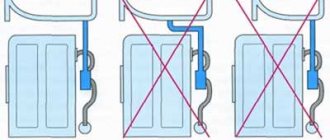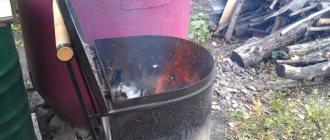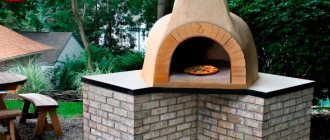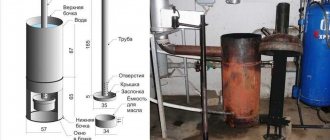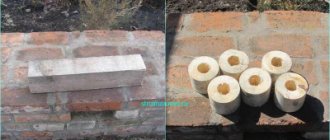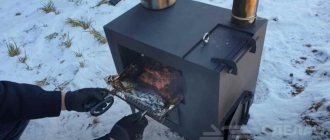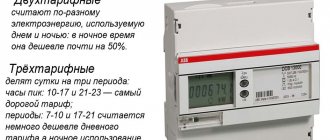A wood chipper is a heating device that runs on wood chips, branches and other similar materials.
Those models that are available in regular and online stores do not always correspond to a given situation.
That is why they are often made independently.
In this article we will show you how:
- choose shape and size;
- choose metal;
- draw up a drawing;
- make oven parts yourself.
Choosing a shape and size
When choosing a shape and size, it is necessary to take into account several parameters , the main of which are:
- firebox size;
- fuel combustion method;
- weight limit;
- size limit.
Firebox size
This parameter affects the amount of fuel that the stove can hold, and therefore the amount of thermal energy it will produce as a result of combustion.
The parameters of the firebox directly affect the efficiency of the heating device in various conditions - the smaller it is , the slower a certain volume of water will heat up .
In other words, a device with a small firebox is suitable for serving by one person. You can boil a mug of tea on it or heat up a can of stew.
more fuel into the stove than the volume of the firebox allows will lead to rapid overheating and damage to individual parts.
To serve a company consisting of two or three people, the most effective volume of the firebox will be 1 dm3, that is, a cube with a side size of 10 cm. For a company of 3-5 people, a cube with a side of 15 cm will be optimal.
These values are only guidelines and do not have to be strictly followed. In addition, even a small stove with a firebox size of 1 dm3, if used correctly, can provide food for 3-4 people without deformation of parts, although you will have to use instant products and spend more time heating water.
Pyrolysis and conventional methods of fuel combustion
There are 2 main ways of burning fuel:
- ordinary;
- pyrolysis.
For normal fuel combustion, it is enough to make the most primitive metal box, which will direct the bulk of the pyrolysis gases and flame upward.
The efficiency of this method of burning wood is low , and due to the high content of unburnt cellulose particles that have turned into soot, the surface of the water container becomes covered with soot and turns black. Therefore, the only advantage of the conventional combustion method is the simplicity of the design of the heating device.
, thermal decomposition of wood occurs with a partial lack of air and a small amount of fire.
Then, in the so-called pyrolysis block, the smoke is mixed with secondary air, which enters through the holes in the stove body, and afterburning occurs. That is, part of the carbon monoxide (carbon monoxide), which is formed during the thermal decomposition of wood, is converted into carbon dioxide with the release of thermal energy.
With this burning method, the cellulose that makes up the wood burns more completely, releasing more heat , so less fuel is needed to heat the same amount of water.
In addition, the pyrolysis method is better suited for raw wood, but the main type of fuel for such stoves is what can be picked up underfoot, that is, branches, bark and cones, which in most cases have a fairly high humidity.
Weight and size limit
Those who have gone on multi-day hikes over long distances know how much stuff and food they need to take with them, and understand the importance of every extra gram. For such tourists, the weight of the wood chip stove is the determining factor.
The weight depends not only on the design and size of the heating device, but also on the thickness of the metal from which the stove was made. Therefore, you have to choose between the thickness of the metal and the weight limit.
The thicker the metal, the easier the stove can withstand accidental overheating (this is only true for steel, so parts for titanium camping heaters are made very thin, that is, 0.4–0.6 mm).
On long hikes, it is very important to use the most compact things possible, because the volume of a backpack is limited, and you need to take a lot with you.
In such conditions collapsible devices are preferable , because when folded their size does not exceed the dimensions of a not too large book or tablet.
However, this type of heating device is noticeably more difficult to manufacture and slightly less efficient. If there is no strict size limitation , then it is better to choose a non-collapsible or partially collapsible design.
Comparison of different models
It is impossible to compare the effectiveness of wood chip stoves based on descriptions in stores, because sellers are interested in selling their goods, so they often exaggerate the advantages and hush up the disadvantages of the models.
We decided to objectively talk about the pros and cons of the most popular heating devices, focusing on the opinions of the inhabitants of various forums and videos on YouTube.
After all, both the posts in the forums and the videos posted were left by people who actually used certain models of stoves and formed some kind of opinion about them.
Pass
This wood chipper is sold through the social network VKontakte, but the manufacturer is unknown. Nevertheless, the stove is in demand, because its parts are made of titanium, so it is lighter than its steel counterparts and can withstand overheating more easily .
However, the rather high price (more than 2,000 rubles) scares off many potential buyers. On the same page there are also steel analogues under the same brand. They are noticeably heavier and cheaper, so a potential buyer will be able to choose what is best suited for his conditions.
Survivalist 5 double VZhK
Quite a large Russian stove, on which you can simultaneously install 2 army pots.
The wood chipper is available in various versions , which differ in the thickness of the metal.
With careful use, even a thickness of 1 mm, and such a design weighs 820 grams, lasts for several years , then some of the parts become deformed and they have to be either straightened or replaced.
The Survivalist has no special abilities ; it is an ordinary stove with a small afterburning zone and not too high efficiency.
Glow "Track"
Folding round wood chipper designed for heating a small amount of water (0.5–1 l). Despite the small thickness of the metal, it is quite resistant to deformation.
Most of those who have purchased and actively use it notice that when heating a small volume of water, it is more efficient than most rectangular analogues.
However, trying to heat a larger volume of water leads to serious problems. After all, you have to remove the container from the heating device, fill the wood chipper with new fuel and return the container to its place. Therefore, it is still suitable for a solo hike, but for a company of 2 or more people, it is better to take something else .
Main types of homemade stove designs
Here are the main types of structures :
- non-removable;
- partially collapsible;
- completely collapsible.
The advantages of a non-separable design are maximum rigidity and strength , the main disadvantage is the large size. A partially collapsible oven consists of several blocks, so its strength and rigidity directly depend on the same parameter of each block.
Fully dismountable in transport condition it takes up little space , but its rigidity and strength are not only noticeably lower than the same parameters of the two previous designs, but also directly depend on the quality of workmanship.
Based on the type of fuel combustion, these devices are divided into 3 main designs:
- traditional;
- with lower secondary air supply;
- with upper secondary air supply.
The first consists of walls and a bottom, so its design is the most primitive and easiest to manufacture. The second is noticeably more complicated, because it is formed from outer and inner buildings installed on a common bottom. Secondary air, which did not enter through the grate holes, freely passes between the outer and inner casings.
Product from an old washing machine
Armed with a grinder, you need to cut off a small part of the stainless metal from the used drum. For subsequent work, you need a strip of stainless steel about 20 cm wide. It precisely determines the height of the future device. The length of the prepared material from which the pipe will be twisted should be about 65 cm. A side hole with a tight door must be made in the structure. Fuel material is placed in it, and when closed, the heat is directed to the burner.
Stepping back a little from the top edge, holes should be made for the skewers, and a grid is created at the top on which the dishes are placed. In the lower part there is a grate with several holes for pegs, which act as fixing elements.
Selecting a housing type
All stoves can be divided into:
- rectangular;
- round.
rectangular because the parts for this shape are easy to manufacture.
Round ones are more difficult to manufacture, so they are made from ready-made cylinders or glasses made of a suitable metal.
Even if a round heating device is made collapsible, in transport condition it will always be noticeably larger than a rectangular one.
Material selection
For the manufacture of wood chip stoves, acid-resistant and heat-resistant steel grades are used , because they not only tolerate high temperatures well, but are also resistant to condensation that forms during ignition.
This metal is used for the internal lining of furnaces and boilers, as well as for the manufacture of drums and internal casings of washing machines.
Air ducts for ventilation systems are often made from this steel, but you need to be careful not to confuse it with galvanized steel, which has much worse characteristics and releases zinc when heated, which can lead to poisoning.
also necessary to choose the right metal thickness . After all, the thinner the part, the less rigid and durable it will be (even if it weighs less), but at the same time it is noticeably easier to process. And the thicker it is, the stronger the structure will be, but the greater its weight, and the processing will be noticeably more difficult.
Therefore, most often for home-made stoves, stainless steel with a thickness of 1–1.5 mm is used , although both thinner and thicker metal can be used.
As a basis for the manufacture of round heating devices, you can use spoon dryers of various diameters , made of food grade stainless steel.
Such dryers can be bought on AliExpress and other sites for a low price. Metal thermoses are well suited for creating pyrolysis stoves , because they are also made of stainless steel.
However, they are quite difficult to drill due to their round shape and the inability to use a drilling machine, and for complete pyrolysis, the air flow in the combustion zone should be minimal, and in the afterburning zone located above the combustion zone, maximum.
Often, various steel containers are used to make wood chippers , such as:
- saucepans;
- mugs;
- pots;
- banks.
The main selection conditions are :
- heat resistance;
- acid resistance;
- compliance with the size and shape of the water container that will be installed on top.
Advantages of the device
The device has many advantages, the main ones include the following:
- Mobility and small overall dimensions;
- Open flame guard;
- Versatility in the types of fuel used;
- Ease of manufacture;
- High heating rate;
- Directional heating.
Furnaces are collapsible and monolithic. Both types of devices have compact overall dimensions and low weight, making them easy to carry in hand luggage. The operation of the stove is characterized by the protection of an open flame, ensuring a minimum level of fire safety. Any available materials of wood origin can be used as fuel - wood chips, sticks, branches, and so on. The stove has a high heating rate due to high-quality combustion with a good excess of air. Upward-directed heating allows you to use a small amount of fuel, unlike a fire, which does not have a concentration and direction of heating and requires a larger amount of firewood.
With a small set of tools and common materials, any craftsman can make a wood chipper himself, even from a tin can.
The disadvantages of the stove are:
- Short service life;
- Temperature deformation of metal;
- Hot surface;
- The furnace body is constantly covered in soot.
Manufacturing
The manufacturing technique for different types of wood chip stoves is different , but often the same operations are used in the manufacture of structures of different types. Therefore, we will talk about each operation, and also give a sequence of actions for various types of these devices.
This will allow you not only to manufacture devices for which there are descriptions and drawings with dimensions, but also to develop your own models.
After all, often through experimentation it is possible to create something much more effective than what is described on forums or found on the Internet.
But to start making it by reading forums where homemade wood chippers and everything connected with them are discussed. In addition, it would not hurt to read discussions regarding the experience of using purchased stoves, because from there you can glean many interesting ideas or unusual solutions.
Here is
a list of the most popular and authoritative forums where these issues are discussed:
- Yaplakal;
- Popgun;
- Khabarovsk Cyclists Forum;
- Vestigator;
- Velopiter;
- Center for the Study of Adaptive Skills;
- Theron.
Manufacturing of parts for rectangular devices
First you need to make a full-size mock-up of all the parts from thick hard cardboard. This will help you more accurately determine the shape of each part, as well as the size and shape of the mounting slots and protrusions.
When making parts from cardboard, do not make holes in them, because they will weaken the material and you will not be able to assemble the structure properly. Having decided on the shape of each part and checking them using assembly, the cardboard sample is placed on a sheet of metal and the contours are marked .
To cut stainless steel or tool steel at home, use :
- grinder (it is necessary to constantly water the contact area between the disc and the metal with water);
- special guillotine shears (not to be confused with ordinary metal shears);
- jigsaw (use a special blade and set the speed as low as possible).
You can cut along the contour of the plate in any way, but the slots for assembling the parts will have to be made with a jigsaw, because guillotine shears are not intended for such work, and the grinder makes too wide a cut.
If there are burrs , they are removed using :
- sharpening machine;
- flat file;
- flat file.
When all the parts are ready, holes are drilled using carbide drills for hardened metal . Moreover, you need to drill at low drill speeds so as not to overheat the plate or drill. If you set the speed to medium, then the contact point between the plate and the drill will need to be watered to reduce the temperature and protect against overheating.
Manufacturing of round furnaces
Most often, various stainless steel containers are used to make round (cylindrical) wood chips. First, a drawing is drawn up or a full-size mock-up is made, on which the location, shape and size of the holes are determined. Then they transfer the holes for the holes to the container and drill them.
In most cases , you have to drill containers using a hand drill , because due to their large size and round shape, they cannot be properly secured to the bed of a drilling machine.
Therefore, the holes for the holes are first punched with a sharp core and drilled in 2-3 steps, gradually increasing the diameter of the drill.
To create the maximum pyrolysis effect, the holes in the lower part of the active combustion zone are made minimal , then gradually enlarged, making them maximum (the size depends on many factors, it must be selected individually) in the upper active combustion zone .
In the afterburning zone, the diameter of the holes is reduced to a minimum (1–2 mm) as you move towards the upper part of the stove.
It is advisable to cut a rectangular hole for storing fuel , and the cut piece of metal can be used as a door.
Rings made of rigid steel wire with a diameter of 0.5–2 mm can be used as canopies.
If a container is used to make a stove into which a container of water will be inserted, then chimney holes must be cut in the upper part. For structures where there is 1–2 cm of free space between the edge of the stove and the water container, such holes are not required.
a stainless steel thermos is used as a base , then in addition to the fuel door you also need to cut out the ash pan door, the width of which is slightly greater than the distance between the outer and inner casings, and the length is equal to ¼ of the circumference of the casing.
The door needs to be secured to a pair of hinges made of paper clips or steel wire and some kind of retainer installed. However, you can do without a door, leaving the ash removal hole open.
Then in the bottom of the inner casing you need to drill 3-5 holes with a diameter of 10 mm , through which the ash will pour out. In the upper part of the thermos you need to cut chimney holes, the size of which depends on the height of the side.
If its height is 2 cm or more, then the total area of the holes should be half the area of the side. With a side height of 1.5 cm, the total area of the holes should be 2/3 of the side area , and with a height of 1 cm, the total area of the chimney openings should be ¾ of the side area.
It is desirable that the holes go all the way to the top, but you can leave a side 1–3 mm high. If you make it larger, the stove will effectively heat only containers whose diameter is at least twice the diameter of the rim.
cutlery
drainer or a piece of thin-walled pipe is used
as a base the grate bars can be made from screws , the length of which is 40–45% of the inner diameter of the pipe.
Holes for bolts are drilled at a height of 2–3 cm from the bottom of the pipe, their optimal number is 6–8 pieces.
When the holes are ready, the bolts are inserted from the outside and secured from the inside with nuts and locknuts.
In the pipe below the grate, you can drill 2–4 holes with a diameter of 5–10 mm, thanks to which the combustion process will continue in an economical mode even with the door completely closed. If the stove has an afterburning chamber, then the number and diameter of the holes can be reduced by 2 times.
How to do it on a hike?
If the standard stove is out of order, and there is no access to plumbing and welding tools, then you can make a wood chipper from any tin can. It will not last long, but it will last for 1-2 weeks.
To do this, the lid of the jar must first be cut lengthwise with a penknife or hunting knife , and then cut in a circle so that you get 2 petals connected to the jar with legs 3–4 cm wide.
Then these petals are unbent and the contents of the jar are removed, after which a platform for heated containers is formed from the petals. When the site is ready, you need to make holes in the sides of the can for air flow . This operation can be done using a bottle opener or a knife.
The size and diameter of the holes are selected individually, but do not be afraid, even if there are too many of them, or they are too large, the stove will still successfully cope with its tasks.
The only disadvantage of this design is that it can only heat a small volume of water due to the impossibility of adding fuel .
If one stowage is not enough, then instead of holes for air flow, a door for stowing fuel is cut out with a knife, which is then bent downwards so that it serves as an additional support.
Turbo stoves
In stores you often find turbo stoves, that is, ordinary wood chippers with forced air supply. Their main advantage is that they work well even on raw fuel .
To make them you will need :
- a small diameter tin can (you can use a metal mug or a thin-walled pipe);
- electric motor from DVD drive;
- steel wire with a diameter of 1–2 mm;
- copper flexible insulated wire;
- box for AA or AAA batteries (can be bought in a store or removed from some device);
- AA or AAA batteries (the larger, the longer they will last).
The bottom of the can is cut off, then a multi-blade propeller is made . The number of blades does not matter; their deflection angle is 10–15 degrees. The size of this propeller should be slightly smaller than the internal diameter of the turbine housing , i.e. a tin can, pipe or mug.
The main problem in making this device is that the tin propeller is difficult to fix on the tin shaft. After all, there is a source of high temperature nearby, and the size and weight limits do not allow making the pipe too long.
When the fan unit is ready, it is joined to the stove body, positioned under the grate. If the distance from the grate to the ground is less than the diameter of the turbo, then a new housing or adapter is made that increases this distance and connects both blocks.
If the turbocharger is connected to a thermos stove, then the grate bars are raised to the level of the motor shaft, and the bottom of the fan pipe is installed at the level of the bottom of the inner housing.
Features of the work
A wood chip stove for an army cauldron is perfect. If you decide to use the second version of the device of this design, then at the first stage you need to mark the sheet of metal using a template created in advance. After this, the shape and technological holes are cut out. As you strike with the hammer, you will be able to bend the sheet. The furnace body should be round; a metal pipe must be used to give the desired shape. The main thing is to choose the right diameter.
